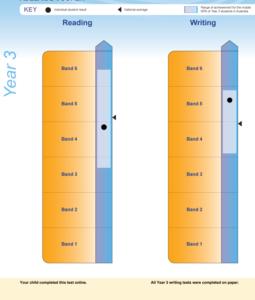Date : July 23, 2022
Wondering What The Year 3 NAPLAN Reading Test Measures?
If your Year 3 child has undergone their NAPLAN reading test and come out with a disappointing result, you may be wondering where you should go from here. NAPLAN is a standardised test and schools often place a lot of emphasis on it, so what can a disappointing result mean for your child? What does the test measure? These are excellent questions. We’ve done the heavy lifting for you and come up with the answers to these questions and more.
What is the Year 3 NAPLAN reading test, and what does it cover?
The Year 3 NAPLAN reading test measures the literacy achievements of students against benchmarks, as well as the performance of educational programs and schools. The test’s focus is on the reading and interpretation of written English. The aim is to ensure that students and the nation’s literacy skills are improving. At a Year 3 level, the test generally has students decipher meaning from short stories or simple reports which usually have some sort of visual element. The student makes connections between simple information and between text and pictures.
What is the test like? What would my child have done during the test?
During the test, your child would be provided with a magazine containing a range of short texts that illustrate different writing styles. Students read these short stories and then answer the questions in a separate booklet. All in all, the test takes about 45 minutes.
Where is it useful? Where isn’t it useful?
NAPLAN is useful in that it measures the literacy skills of students in comparison to their peers in the same year level, giving a rough indication of their progress. It provides a national benchmark to give teachers an idea of where the student is in regard to their skill levels, based on the performance of other students and schools. Over a 10 year period, NAPLAN data has identified differences in the achievements of boys and girls, the effects a parent’s level of education can have on their child, and areas of disadvantage. But it only tells a narrow part of the story.
Standardised testing is biased in that only certain aspects of literacy are tested. It doesn’t measure creativity or engagement, only a narrow skillset on one day. It also frames mistakes as a bad thing. If schools are to encourage original thought in their students, then making mistakes is an essential part of that. Lateral and creative thinking is required to solve complex problems, which these standardised NAPLAN tests do not measure. In short, NAPLAN tests are really testing the effectiveness of school educational programs, not the individual achievements of your child.

What does a poor result mean?
The NAPLAN test will provide your child with a score on a band scale of 1 to 6, with 6 being the highest. At a Year 3 level, the national minimum standard is a band 2. If you’re really worried about your child’s reading skills, you can speak to their teacher. But keep in mind that NAPLAN scores are not used to determine entry into selective schools or into university when they’re older. What matters is that you foster a love of reading in your child – this will become their greatest asset in their future studies and throughout their adult lives.
For more information on literacy or activities you can do with your children to improve their reading skills, check out May Gibbs!
 Librarian Bec
Librarian Bec
Right now, Librarian Bec’s hard at work at your local library, sharing a passion for reading with little people and big. Bec writes about inspiring little readers and embracing lovely literature.



